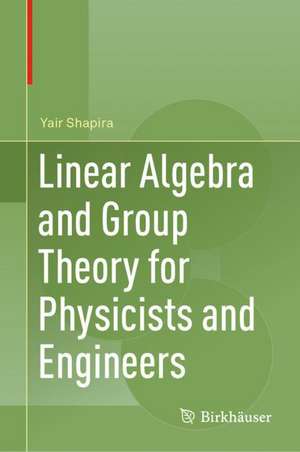Linear Algebra and Group Theory for Physicists and Engineers
Autor Yair Shapiraen Limba Engleză Hardback – 21 mai 2019
This textbook demonstrates the strong interconnections between linear algebra and group theory by presenting them simultaneously, a pedagogical strategy ideal for an interdisciplinary audience. Being approached together at the same time, these two topics complete one another, allowing students to attain a deeper understanding of both subjects. The opening chapters introduce linear algebra with applications to mechanics and statistics, followed by group theory with applications to projective geometry. Then, high-order finite elements are presented to design a regular mesh and assemble the stiffness and mass matrices in advanced applications in quantum chemistry and general relativity.
This text is ideal for undergraduates majoring in engineering, physics, chemistry, computer science, or applied mathematics. It is mostly self-contained—readers should only be familiar with elementary calculus. There are numerous exercises, with hints or full solutions provided. A series of roadmaps are also provided to help instructors choose the optimal teaching approach for their discipline.
| Toate formatele și edițiile | Preț | Express |
|---|---|---|
| Paperback (1) | 454.92 lei 38-44 zile | |
| Springer International Publishing – 17 ian 2024 | 454.92 lei 38-44 zile | |
| Hardback (2) | 403.31 lei 3-5 săpt. | +43.69 lei 4-10 zile |
| Springer International Publishing – 21 mai 2019 | 403.31 lei 3-5 săpt. | +43.69 lei 4-10 zile |
| Springer International Publishing – 17 ian 2023 | 553.33 lei 3-5 săpt. |
Preț: 403.31 lei
Nou
Puncte Express: 605
Preț estimativ în valută:
77.17€ • 80.78$ • 64.23£
77.17€ • 80.78$ • 64.23£
Carte disponibilă
Livrare economică 10-24 martie
Livrare express 21-27 februarie pentru 53.68 lei
Preluare comenzi: 021 569.72.76
Specificații
ISBN-13: 9783030178550
ISBN-10: 3030178552
Pagini: 380
Ilustrații: XXXI, 441 p. 93 illus., 1 illus. in color.
Dimensiuni: 155 x 235 x 33 mm
Greutate: 0.88 kg
Ediția:1st ed. 2019
Editura: Springer International Publishing
Colecția Birkhäuser
Locul publicării:Cham, Switzerland
ISBN-10: 3030178552
Pagini: 380
Ilustrații: XXXI, 441 p. 93 illus., 1 illus. in color.
Dimensiuni: 155 x 235 x 33 mm
Greutate: 0.88 kg
Ediția:1st ed. 2019
Editura: Springer International Publishing
Colecția Birkhäuser
Locul publicării:Cham, Switzerland
Cuprins
Part I Introduction to Linear Algebra.- Vectors and Matrices.- Vector Product in Geometrical Mechanics.- Markov Chain in a Graph.- Special Relativity - Algebraic Point of View.- Part II Introduction to Group Theory.- Group Representation and Isomorphism Theorems.- Projective Geometry in Computer Graphics.- Quantum Mechanics - Algebraic Point of View.- Part III Polynomials and Basis Functions.- Polynomials and their Gradient.- Basis Functions: Barycentric Coordinates in 3-D.- Part IV Finite Elements in 3-D.- Automatic Mesh Generation.- Mesh Regularity.- Numerical Integration.- Spline: Variational Model.- Part V Advanced Applications in Physics and Chemistry.- Quantum Chemistry: Electronic Structure.- General Relativity: Einstein Equations.- References.
Notă biografică
Yair Shapira, PhD, Department of Computer Science, Technion, Israeli Institute of Technology
Textul de pe ultima copertă
This textbook demonstrates the strong interconnections between linear algebra and group theory by presenting them simultaneously, a pedagogical strategy ideal for an interdisciplinary audience. Being approached together at the same time, these two topics complete one another, allowing students to attain a deeper understanding of both subjects. The opening chapters introduce linear algebra with applications to mechanics and statistics, followed by group theory with applications to projective geometry. Then, high-order finite elements are presented to design a regular mesh and assemble the stiffness and mass matrices in advanced applications in quantum chemistry and general relativity.
This text is ideal for undergraduates majoring in engineering, physics, chemistry, computer science, or applied mathematics. It is mostly self-contained—readers should only be familiar with elementary calculus. There are numerous exercises, with hints or full solutions provided. A series of roadmaps are also provided to help instructors choose the optimal teaching approach for their discipline.
Caracteristici
Offers readers a deeper, more intuitive understanding of applied mathematics by introducing linear algebra and group theory together
Adopts an interdisciplinary approach, making it flexible enough to appeal to engineers, physicists, chemists, computer scientists, and more
Provides an array of examples throughout, perfect for practicing what is taught
Adopts an interdisciplinary approach, making it flexible enough to appeal to engineers, physicists, chemists, computer scientists, and more
Provides an array of examples throughout, perfect for practicing what is taught
